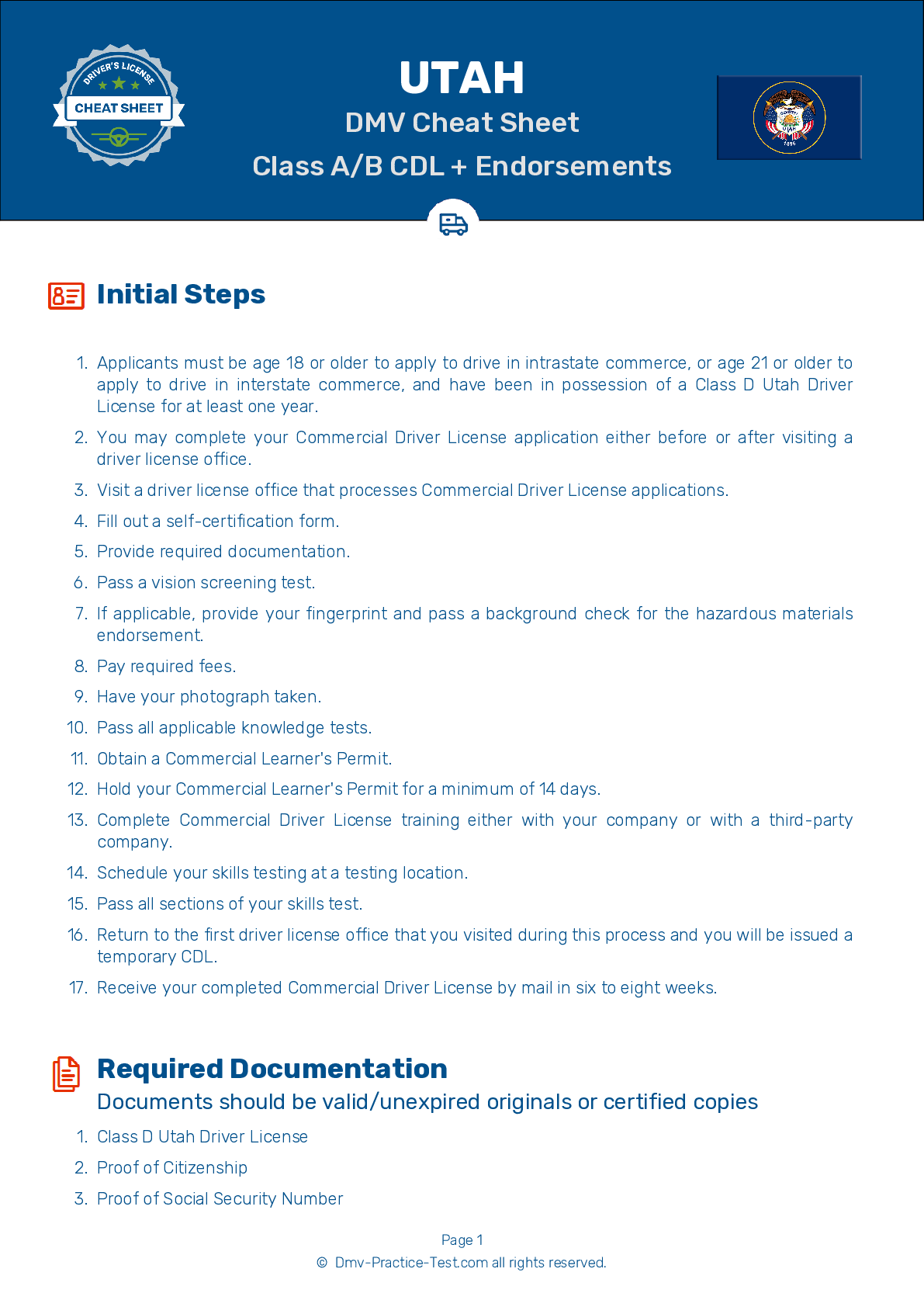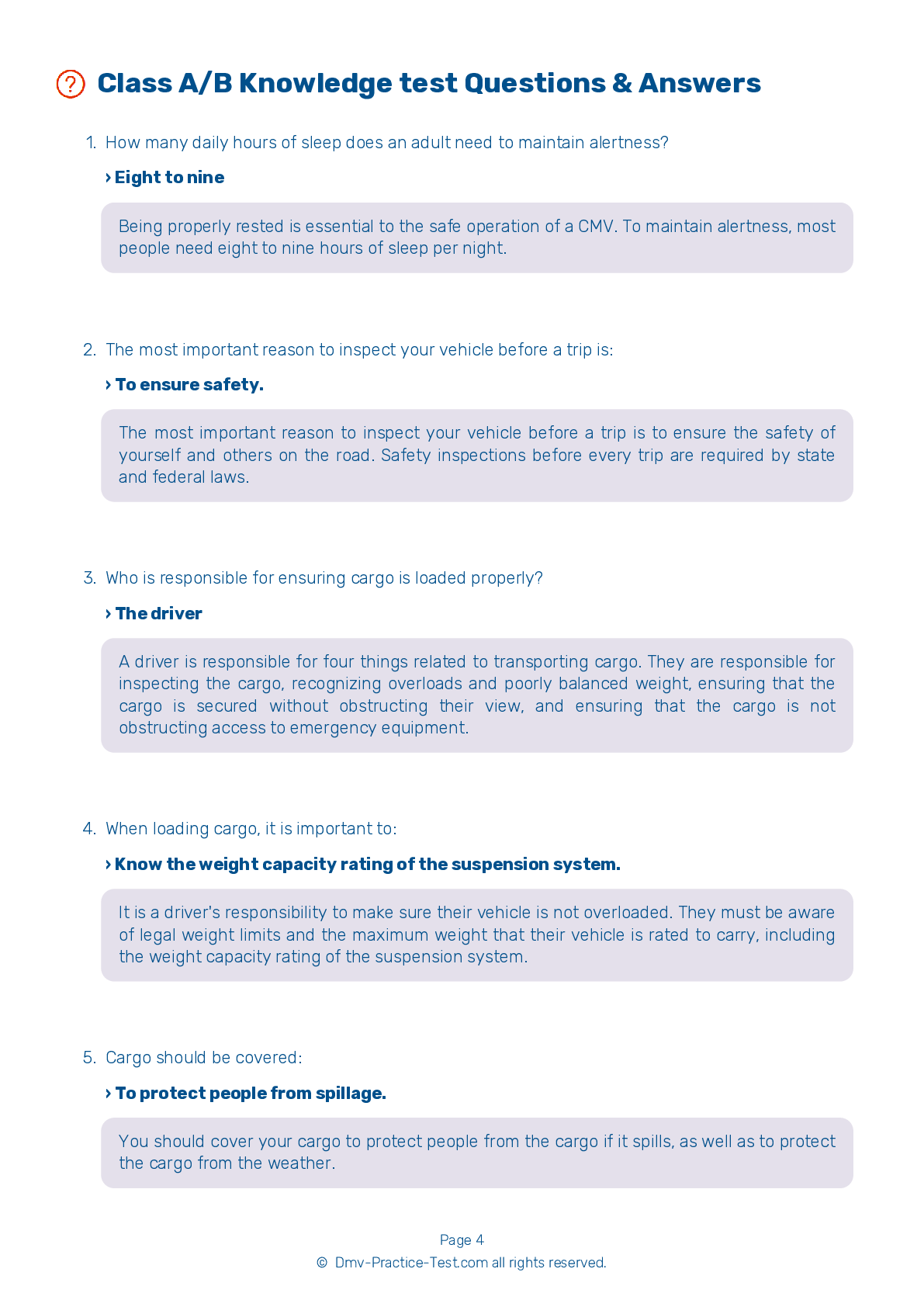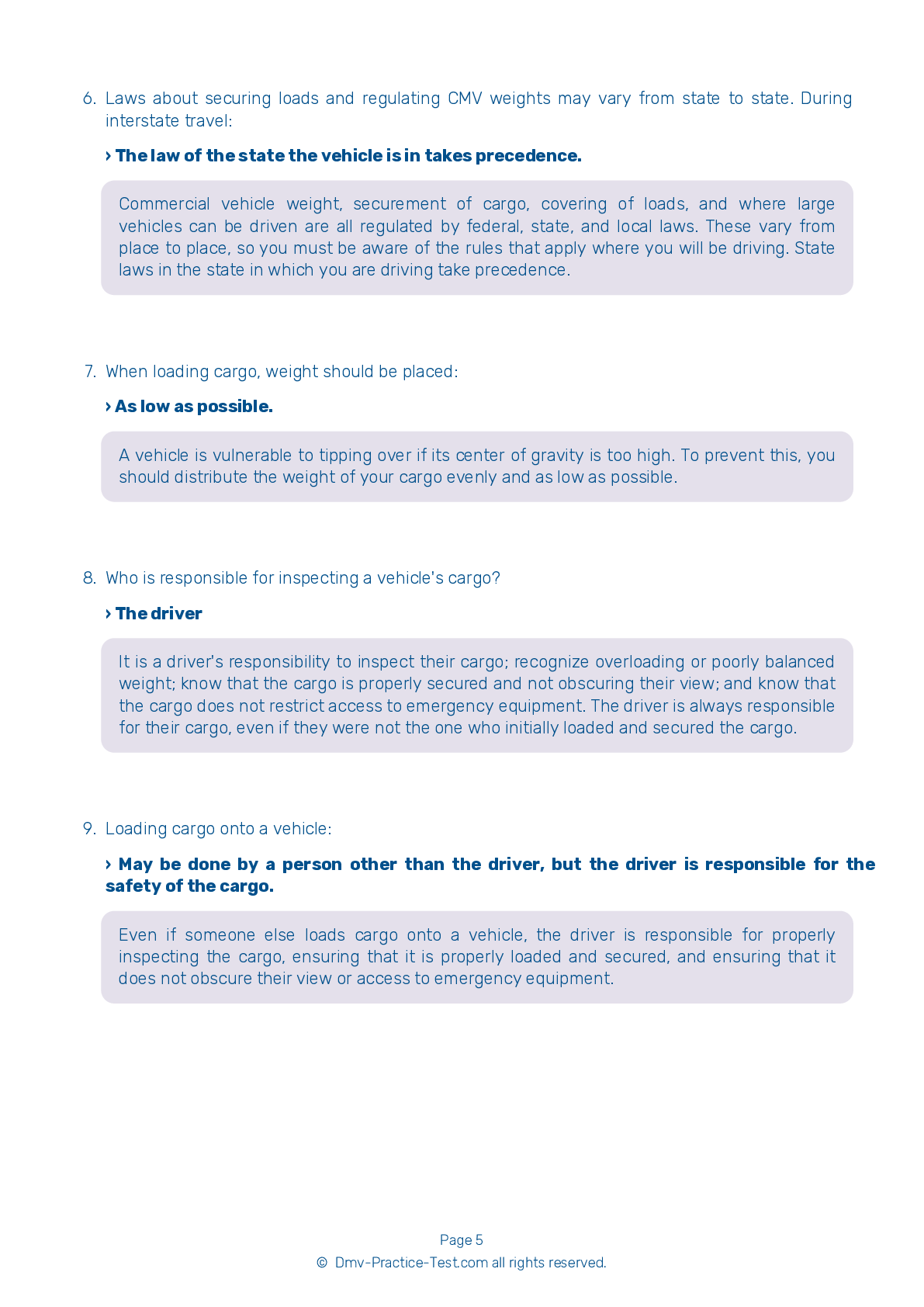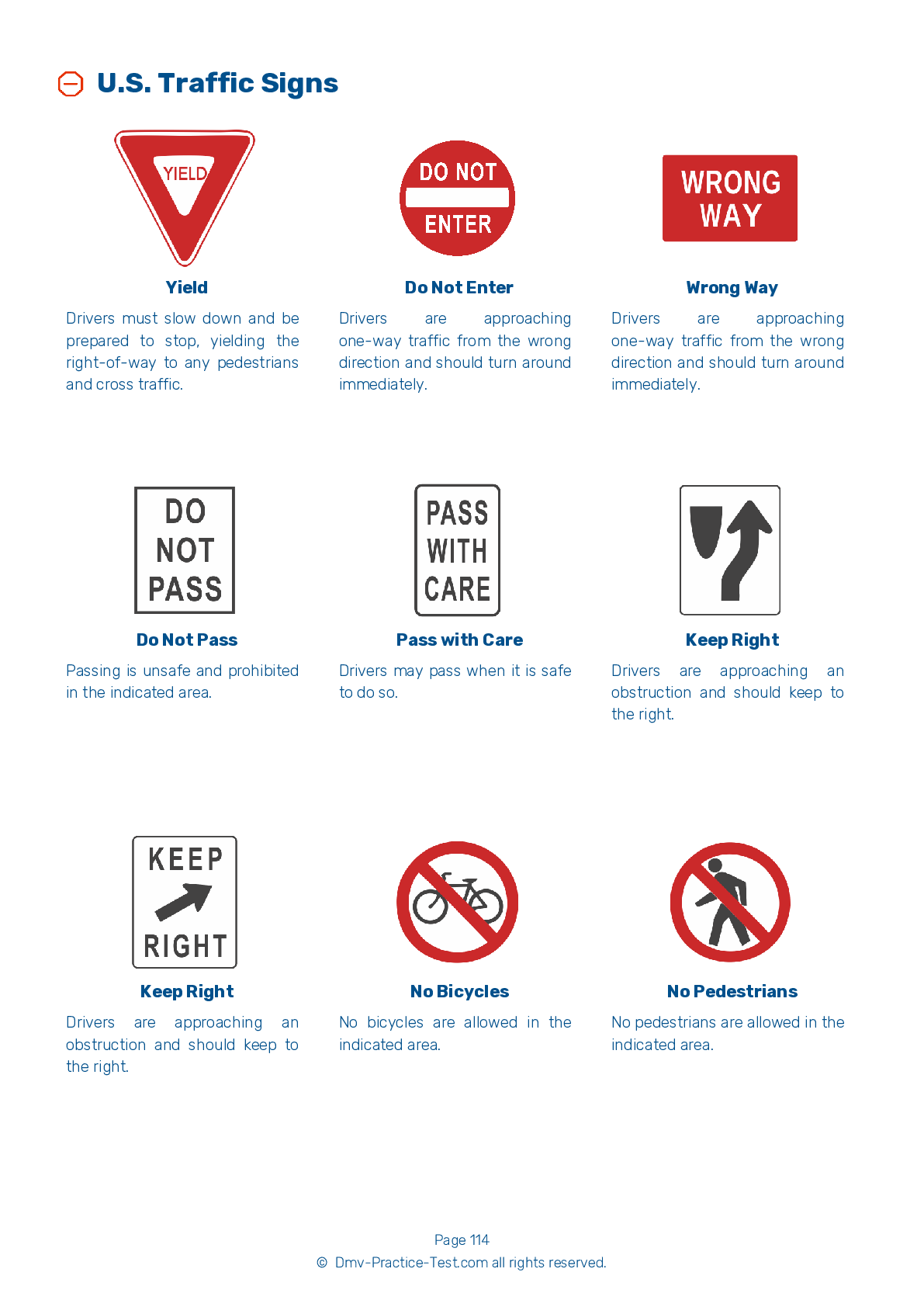Knowledge Test Class A #1
Class A Driving Test | Utah 2025 #1 Page 6 of 7
Train for FREE online with our Utah class A license test. The official exam test consists of several obligatory parts, with all of them checking your knowledge of different blocks of road rules. If you need to obtain a UT CDL class A permit in 2025, practice as much as possible. Free sample tests published on our website will help you check and improve your knowledge and boost your grades. Please bear in mind that CDL class A requirements may vary from state to state.
50
40
20
36 . Rough acceleration:
Should be used to prevent rust from forming.
Always accelerate smoothly and gradually so that your vehicle does not jerk. Rough acceleration can cause mechanical damage.
37 . Which of the following statements is correct?
Welded repairs are acceptable for wheels on rear axles.
Missing clamps, spacers, studs, or lugs can be a dangerous defect. Mismatched, bent, or cracked lock rings are not safe to be used. Wheels or rims with welded repairs are not safe.
38 . If an air compressor is belt-driven, the belt should be routinely checked to ensure that it is:
If your vehicle has air brakes, the air compressor drive belt should be checked before each drive. Check the tightness of the belt and verify that it is in good condition.
39 . What is a danger of rolling back when you start to accelerate?
You may lose your position in traffic.
To avoid hitting someone or something behind you, it is important to ensure that your vehicle does not roll backwards when starting from a stop. If your vehicle has a manual transmission, partly engage the clutch before taking your foot off the brake.
40 . When asked to complete a conventional parallel parking maneuver, you should:
Back into the parking space without passing it first.
You may be asked to complete a conventional parallel parking maneuver into a parking space that is to the right of your vehicle. You should drive past the parking space before backing into it while bringing the rear of your vehicle as close to the rear of the space as possible. Your vehicle should be completely within the boundaries of the space.
41 . Laws about securing loads and regulating CMV weights may vary from state to state. During interstate travel:
The driver can choose which state’s laws to follow.
Commercial vehicle weight, securement of cargo, covering of loads, and where large vehicles can be driven are all regulated by federal, state, and local laws. These vary from place to place, so you must be aware of the rules that apply where you will be driving. State laws in the state in which you are driving take precedence.
42 . Tread depth in the major grooves on a front tire should be at least:
3/4 of an inch.
Tires need to have at least 4/32 of an inch of tread depth in every major groove on the front tires, and at least 2/32 of an inch of tread depth on other tires.
2025 Utah | Frequently Asked Questions
To acquire a CDL Hazmat endorsement in Utah, you must first have a valid Utah CDL. Then, pass the Hazardous Materials Endorsement Knowledge Test, submit to a federal background check and fingerprinting by the Transportation Security Administration (TSA). Finally, you must pay the required endorsement fee. It's recommended to study the Utah CDL Handbook beforehand.
To obtain a CDL Hazmat license, you must have a valid Commercial Driver's License (CDL). You should be at least 21 years old, have a clean driving record, and pass a physical examination. Additionally, you must pass the Hazardous Materials Endorsement Knowledge Test and a TSA background check. It's also important to be proficient in English for reading and speaking.
When applying for a CDL Hazmat endorsement in Utah, you'll need to provide your current CDL, proof of U.S. citizenship or legal presence (like a passport or birth certificate), social security card, and proof of Utah residency. You'll also need to complete the HAZMAT endorsement application and pass the TSA background check.
Yes, there is a dedicated written test for the CDL Hazmat endorsement. It's known as the Hazardous Materials Endorsement Knowledge Test. This test assesses your understanding of the rules and regulations related to transporting hazardous materials. It's recommended to study the relevant sections in your state's CDL handbook before taking the test.
The written test for the CDL Hazmat endorsement covers a variety of topics including: understanding and identifying different types of hazardous materials, rules for safe loading and unloading, proper use of placards and labels, emergency response procedures, and specific regulations regarding the transportation of hazardous materials. It's crucial to study these areas thoroughly.
Yes, there are extra charges associated with acquiring a CDL Hazmat endorsement. In Utah, the endorsement itself costs $9.00. However, you'll also need to pay for a TSA background check, which costs $86.50. Please note these fees are subject to change and it's always best to check the latest fee structure with the Utah Driver License Division.
Yes, a background check and security clearance are required for a CDL Hazmat endorsement. The Transportation Security Administration (TSA) conducts this check, which includes fingerprinting and a review of your criminal history. If you pass the background check, TSA provides a security threat assessment to your state's licensing agency.
Yes, obtaining a CDL Hazmat endorsement requires specialized training and passing a written test. The training covers handling hazardous materials, safety procedures, and emergency protocols. After the training, you must pass the Hazmat endorsement test to demonstrate your understanding of these areas. You also need to pass a TSA background check.
No, it's illegal to transport hazardous materials without a valid Commercial Driver's License (CDL) with a Hazmat endorsement. This endorsement ensures the driver is properly trained and knowledgeable about handling and transporting hazardous materials safely. Driving without the necessary endorsement can result in hefty fines and penalties.
Yes, you can add the CDL Hazmat endorsement to your current CDL license. You don't need to apply for a new CDL. However, you'll have to pass a written test specific to hazardous materials and undergo a TSA background check. Once these are successfully completed, the endorsement will be added to your existing CDL.



